Business Law Assessment 3: Analysis of Contract Law Issues
VerifiedAdded on 2023/03/17
|11
|2408
|43
Report
AI Summary
This report presents an analysis of several business law scenarios, focusing on contract law principles within the context of Australian law. The student examines issues related to offers, acceptance, and the formation of contracts, including the legal implications of communication methods such as telephone calls and voice messages. The report explores the concept of "invitation to treat," the significance of silence in contract formation, and the impact of ambiguities or doubts in the negotiation process. Each issue is addressed with a clear statement of the relevant rule, its application to the facts, and a concluding statement. The report also considers the rights and obligations of parties involved in business transactions and the importance of clear communication and agreement in forming a valid contract. The assignment demonstrates an understanding of legal principles, the ability to analyze scenarios, and apply legal concepts to reach conclusions.
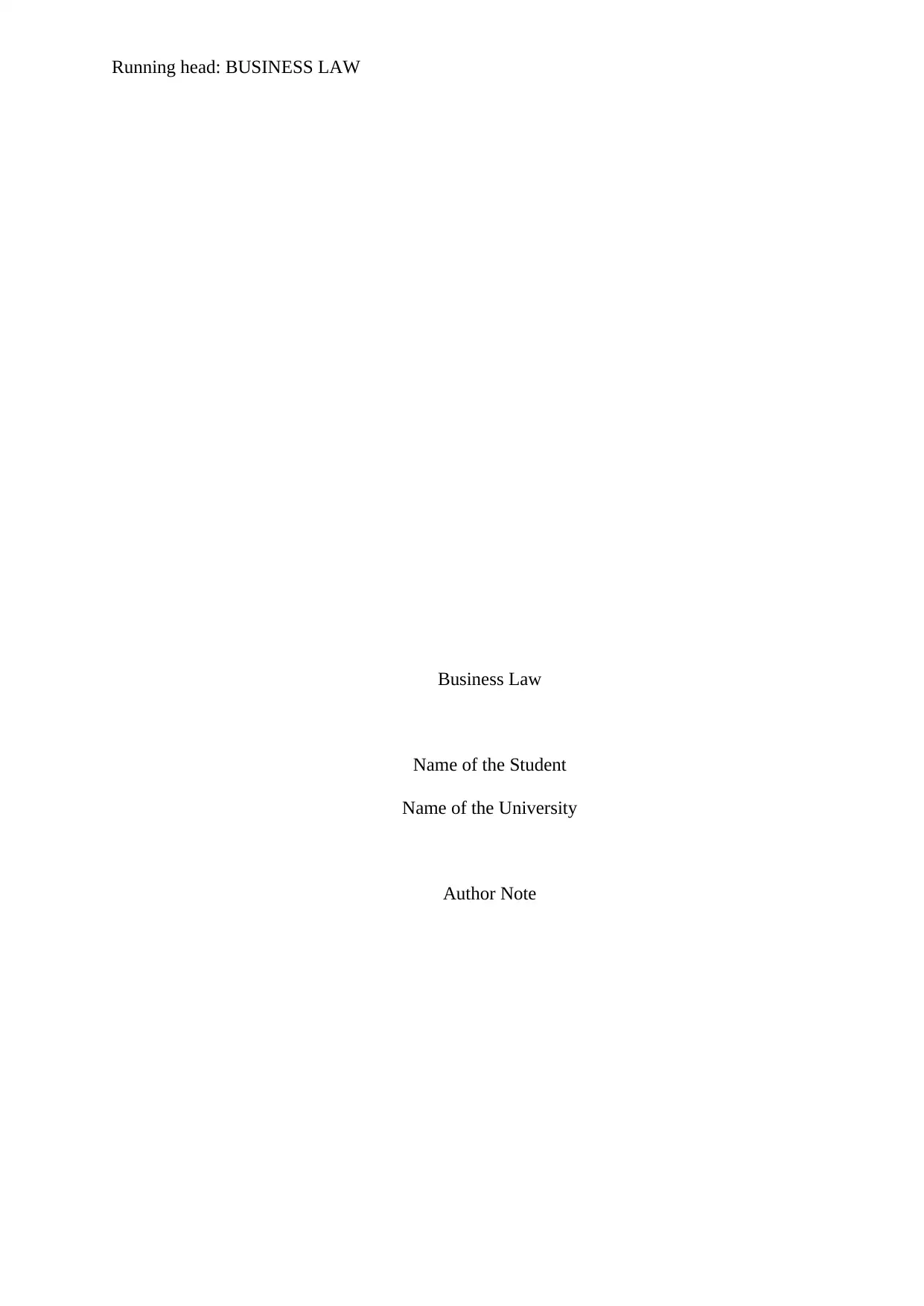
Running head: BUSINESS LAW
Business Law
Name of the Student
Name of the University
Author Note
Business Law
Name of the Student
Name of the University
Author Note
Paraphrase This Document
Need a fresh take? Get an instant paraphrase of this document with our AI Paraphraser
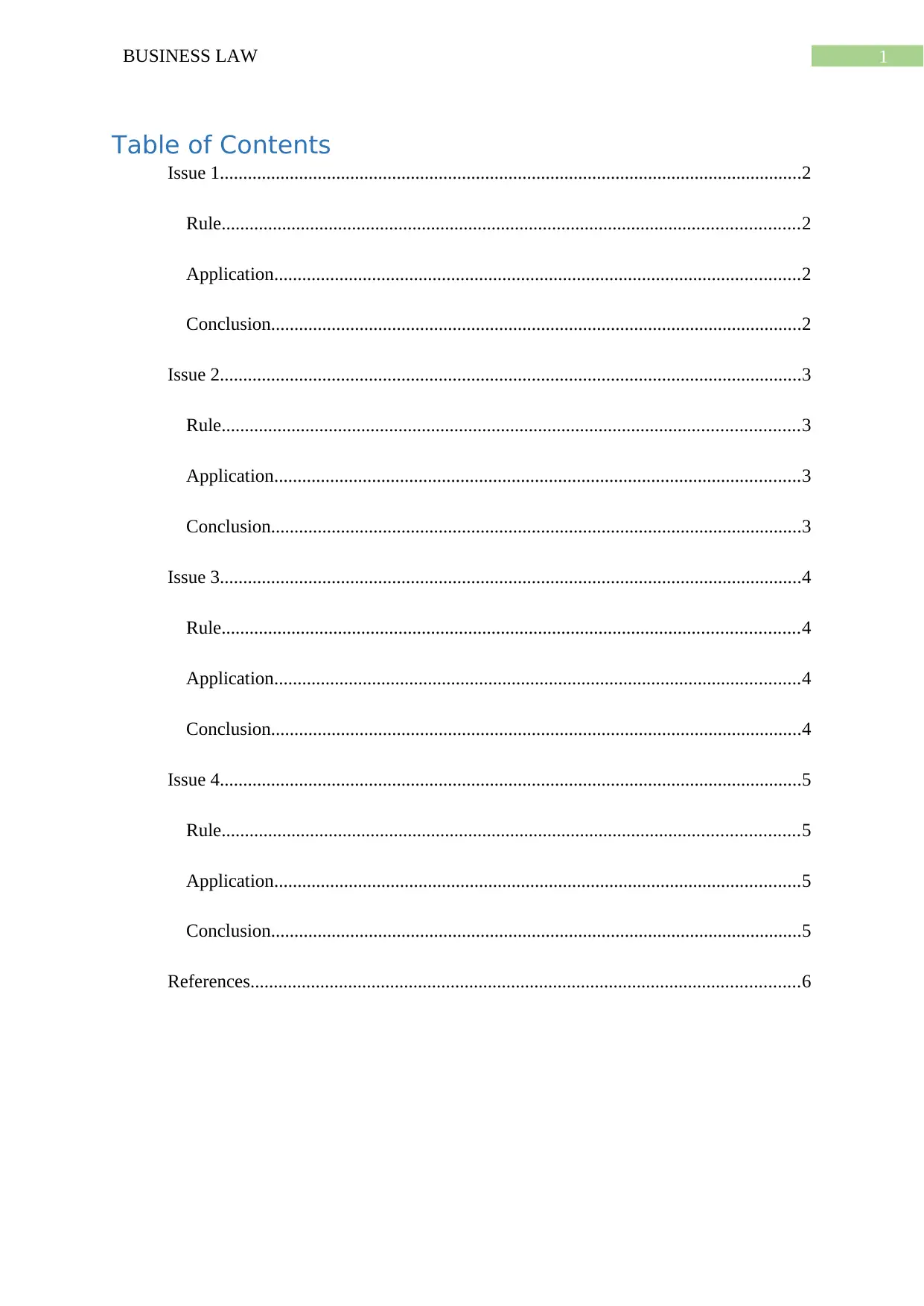
1BUSINESS LAW
Table of Contents
Issue 1.............................................................................................................................2
Rule............................................................................................................................2
Application.................................................................................................................2
Conclusion..................................................................................................................2
Issue 2.............................................................................................................................3
Rule............................................................................................................................3
Application.................................................................................................................3
Conclusion..................................................................................................................3
Issue 3.............................................................................................................................4
Rule............................................................................................................................4
Application.................................................................................................................4
Conclusion..................................................................................................................4
Issue 4.............................................................................................................................5
Rule............................................................................................................................5
Application.................................................................................................................5
Conclusion..................................................................................................................5
References......................................................................................................................6
Table of Contents
Issue 1.............................................................................................................................2
Rule............................................................................................................................2
Application.................................................................................................................2
Conclusion..................................................................................................................2
Issue 2.............................................................................................................................3
Rule............................................................................................................................3
Application.................................................................................................................3
Conclusion..................................................................................................................3
Issue 3.............................................................................................................................4
Rule............................................................................................................................4
Application.................................................................................................................4
Conclusion..................................................................................................................4
Issue 4.............................................................................................................................5
Rule............................................................................................................................5
Application.................................................................................................................5
Conclusion..................................................................................................................5
References......................................................................................................................6
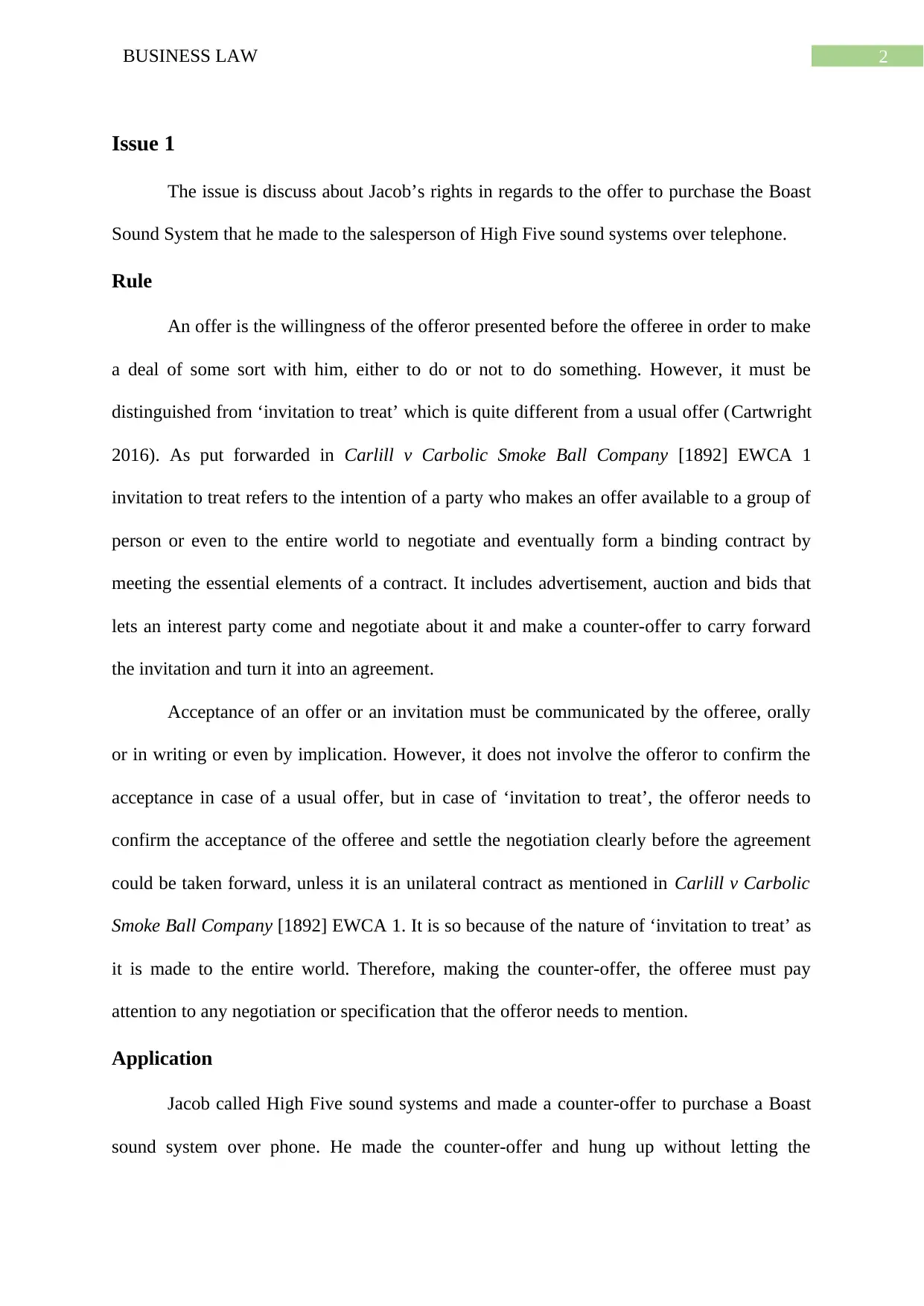
2BUSINESS LAW
Issue 1
The issue is discuss about Jacob’s rights in regards to the offer to purchase the Boast
Sound System that he made to the salesperson of High Five sound systems over telephone.
Rule
An offer is the willingness of the offeror presented before the offeree in order to make
a deal of some sort with him, either to do or not to do something. However, it must be
distinguished from ‘invitation to treat’ which is quite different from a usual offer (Cartwright
2016). As put forwarded in Carlill v Carbolic Smoke Ball Company [1892] EWCA 1
invitation to treat refers to the intention of a party who makes an offer available to a group of
person or even to the entire world to negotiate and eventually form a binding contract by
meeting the essential elements of a contract. It includes advertisement, auction and bids that
lets an interest party come and negotiate about it and make a counter-offer to carry forward
the invitation and turn it into an agreement.
Acceptance of an offer or an invitation must be communicated by the offeree, orally
or in writing or even by implication. However, it does not involve the offeror to confirm the
acceptance in case of a usual offer, but in case of ‘invitation to treat’, the offeror needs to
confirm the acceptance of the offeree and settle the negotiation clearly before the agreement
could be taken forward, unless it is an unilateral contract as mentioned in Carlill v Carbolic
Smoke Ball Company [1892] EWCA 1. It is so because of the nature of ‘invitation to treat’ as
it is made to the entire world. Therefore, making the counter-offer, the offeree must pay
attention to any negotiation or specification that the offeror needs to mention.
Application
Jacob called High Five sound systems and made a counter-offer to purchase a Boast
sound system over phone. He made the counter-offer and hung up without letting the
Issue 1
The issue is discuss about Jacob’s rights in regards to the offer to purchase the Boast
Sound System that he made to the salesperson of High Five sound systems over telephone.
Rule
An offer is the willingness of the offeror presented before the offeree in order to make
a deal of some sort with him, either to do or not to do something. However, it must be
distinguished from ‘invitation to treat’ which is quite different from a usual offer (Cartwright
2016). As put forwarded in Carlill v Carbolic Smoke Ball Company [1892] EWCA 1
invitation to treat refers to the intention of a party who makes an offer available to a group of
person or even to the entire world to negotiate and eventually form a binding contract by
meeting the essential elements of a contract. It includes advertisement, auction and bids that
lets an interest party come and negotiate about it and make a counter-offer to carry forward
the invitation and turn it into an agreement.
Acceptance of an offer or an invitation must be communicated by the offeree, orally
or in writing or even by implication. However, it does not involve the offeror to confirm the
acceptance in case of a usual offer, but in case of ‘invitation to treat’, the offeror needs to
confirm the acceptance of the offeree and settle the negotiation clearly before the agreement
could be taken forward, unless it is an unilateral contract as mentioned in Carlill v Carbolic
Smoke Ball Company [1892] EWCA 1. It is so because of the nature of ‘invitation to treat’ as
it is made to the entire world. Therefore, making the counter-offer, the offeree must pay
attention to any negotiation or specification that the offeror needs to mention.
Application
Jacob called High Five sound systems and made a counter-offer to purchase a Boast
sound system over phone. He made the counter-offer and hung up without letting the
⊘ This is a preview!⊘
Do you want full access?
Subscribe today to unlock all pages.

Trusted by 1+ million students worldwide

3BUSINESS LAW
salesperson confirm or say anything in regards to the offer. This implies that the conversation
pertaining to the purchase of the sound system was not complete as the salesperson had
something to convey to Jacob pertaining to the sale, which did not happen. This can be
marked as an incomplete negotiation of an invitation to treat for it was not a unilateral
contract. The communication of acceptance of invitation to treat was not proper in this case.
Although Jacob made his intentions clear about purchasing the sound system over
phone, yet the salesperson was unable to convey her specifications, which destroys the
elements of a valid counter-offer and its acceptance. Thus there is no agreement between the
parties involved here, thereby no right of Jacob arises here as well.
Conclusion
Jacob shall have no right to this invitation to treat as it lacks the necessary elements to
make an agreement.
salesperson confirm or say anything in regards to the offer. This implies that the conversation
pertaining to the purchase of the sound system was not complete as the salesperson had
something to convey to Jacob pertaining to the sale, which did not happen. This can be
marked as an incomplete negotiation of an invitation to treat for it was not a unilateral
contract. The communication of acceptance of invitation to treat was not proper in this case.
Although Jacob made his intentions clear about purchasing the sound system over
phone, yet the salesperson was unable to convey her specifications, which destroys the
elements of a valid counter-offer and its acceptance. Thus there is no agreement between the
parties involved here, thereby no right of Jacob arises here as well.
Conclusion
Jacob shall have no right to this invitation to treat as it lacks the necessary elements to
make an agreement.
Paraphrase This Document
Need a fresh take? Get an instant paraphrase of this document with our AI Paraphraser
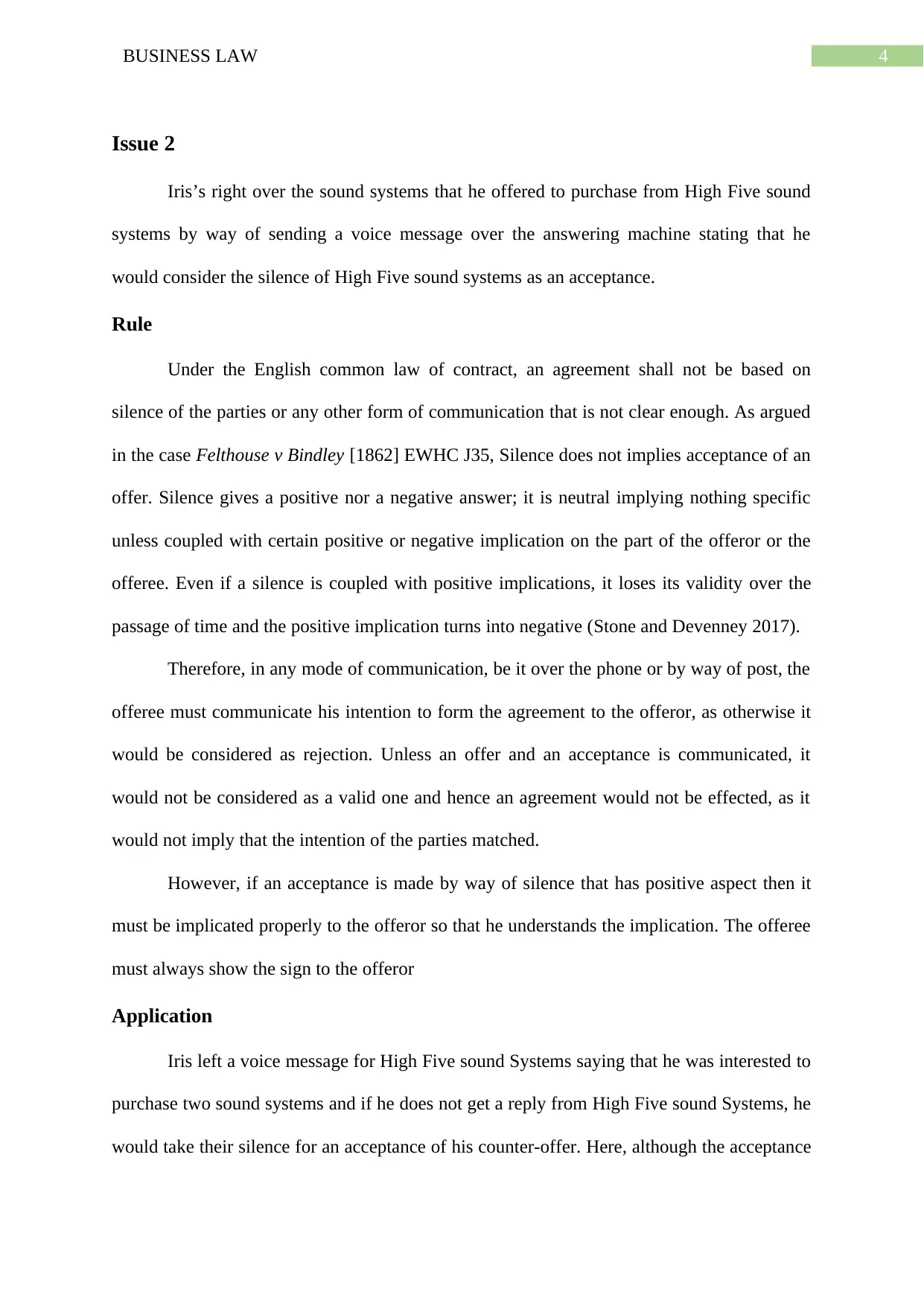
4BUSINESS LAW
Issue 2
Iris’s right over the sound systems that he offered to purchase from High Five sound
systems by way of sending a voice message over the answering machine stating that he
would consider the silence of High Five sound systems as an acceptance.
Rule
Under the English common law of contract, an agreement shall not be based on
silence of the parties or any other form of communication that is not clear enough. As argued
in the case Felthouse v Bindley [1862] EWHC J35, Silence does not implies acceptance of an
offer. Silence gives a positive nor a negative answer; it is neutral implying nothing specific
unless coupled with certain positive or negative implication on the part of the offeror or the
offeree. Even if a silence is coupled with positive implications, it loses its validity over the
passage of time and the positive implication turns into negative (Stone and Devenney 2017).
Therefore, in any mode of communication, be it over the phone or by way of post, the
offeree must communicate his intention to form the agreement to the offeror, as otherwise it
would be considered as rejection. Unless an offer and an acceptance is communicated, it
would not be considered as a valid one and hence an agreement would not be effected, as it
would not imply that the intention of the parties matched.
However, if an acceptance is made by way of silence that has positive aspect then it
must be implicated properly to the offeror so that he understands the implication. The offeree
must always show the sign to the offeror
Application
Iris left a voice message for High Five sound Systems saying that he was interested to
purchase two sound systems and if he does not get a reply from High Five sound Systems, he
would take their silence for an acceptance of his counter-offer. Here, although the acceptance
Issue 2
Iris’s right over the sound systems that he offered to purchase from High Five sound
systems by way of sending a voice message over the answering machine stating that he
would consider the silence of High Five sound systems as an acceptance.
Rule
Under the English common law of contract, an agreement shall not be based on
silence of the parties or any other form of communication that is not clear enough. As argued
in the case Felthouse v Bindley [1862] EWHC J35, Silence does not implies acceptance of an
offer. Silence gives a positive nor a negative answer; it is neutral implying nothing specific
unless coupled with certain positive or negative implication on the part of the offeror or the
offeree. Even if a silence is coupled with positive implications, it loses its validity over the
passage of time and the positive implication turns into negative (Stone and Devenney 2017).
Therefore, in any mode of communication, be it over the phone or by way of post, the
offeree must communicate his intention to form the agreement to the offeror, as otherwise it
would be considered as rejection. Unless an offer and an acceptance is communicated, it
would not be considered as a valid one and hence an agreement would not be effected, as it
would not imply that the intention of the parties matched.
However, if an acceptance is made by way of silence that has positive aspect then it
must be implicated properly to the offeror so that he understands the implication. The offeree
must always show the sign to the offeror
Application
Iris left a voice message for High Five sound Systems saying that he was interested to
purchase two sound systems and if he does not get a reply from High Five sound Systems, he
would take their silence for an acceptance of his counter-offer. Here, although the acceptance
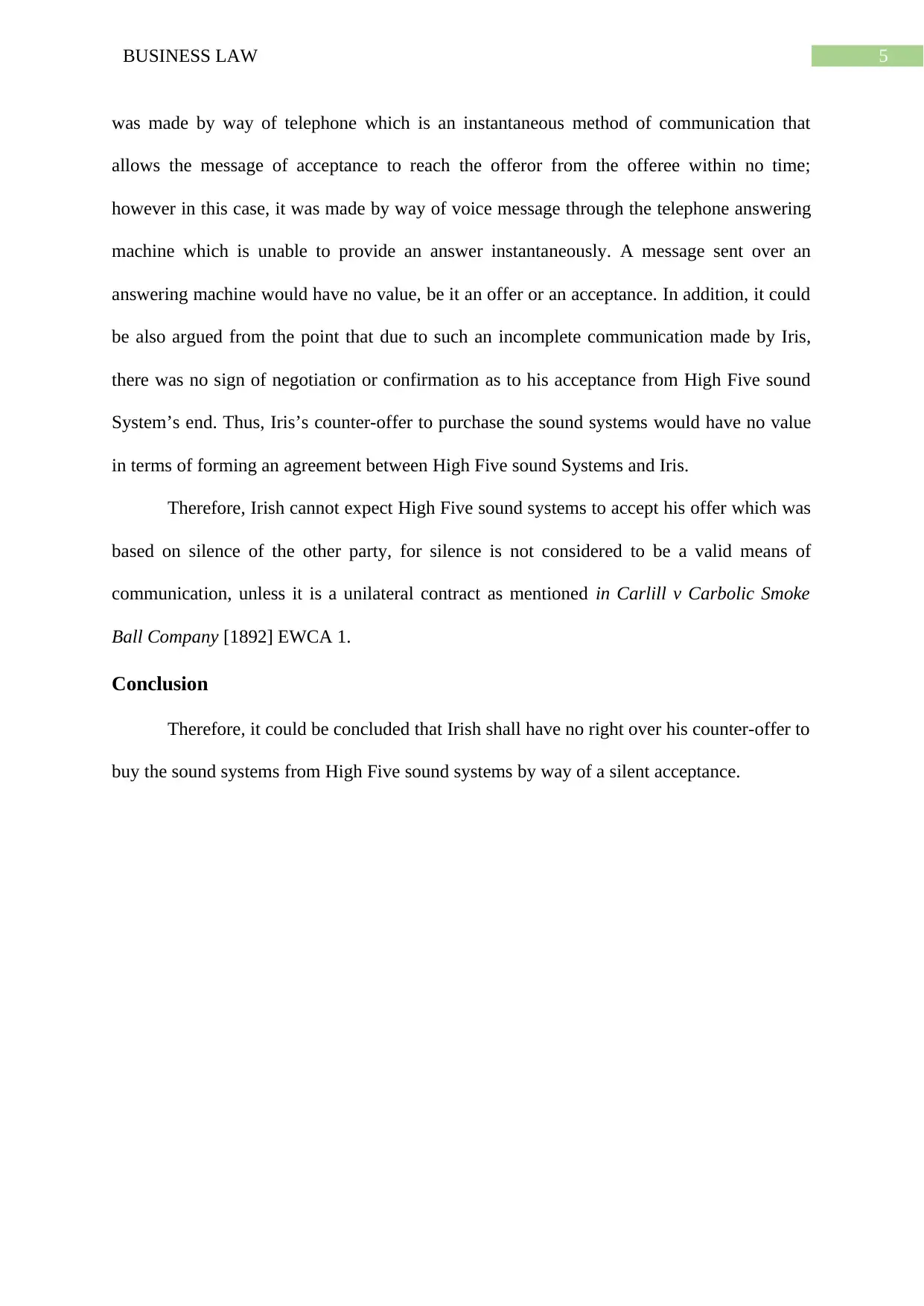
5BUSINESS LAW
was made by way of telephone which is an instantaneous method of communication that
allows the message of acceptance to reach the offeror from the offeree within no time;
however in this case, it was made by way of voice message through the telephone answering
machine which is unable to provide an answer instantaneously. A message sent over an
answering machine would have no value, be it an offer or an acceptance. In addition, it could
be also argued from the point that due to such an incomplete communication made by Iris,
there was no sign of negotiation or confirmation as to his acceptance from High Five sound
System’s end. Thus, Iris’s counter-offer to purchase the sound systems would have no value
in terms of forming an agreement between High Five sound Systems and Iris.
Therefore, Irish cannot expect High Five sound systems to accept his offer which was
based on silence of the other party, for silence is not considered to be a valid means of
communication, unless it is a unilateral contract as mentioned in Carlill v Carbolic Smoke
Ball Company [1892] EWCA 1.
Conclusion
Therefore, it could be concluded that Irish shall have no right over his counter-offer to
buy the sound systems from High Five sound systems by way of a silent acceptance.
was made by way of telephone which is an instantaneous method of communication that
allows the message of acceptance to reach the offeror from the offeree within no time;
however in this case, it was made by way of voice message through the telephone answering
machine which is unable to provide an answer instantaneously. A message sent over an
answering machine would have no value, be it an offer or an acceptance. In addition, it could
be also argued from the point that due to such an incomplete communication made by Iris,
there was no sign of negotiation or confirmation as to his acceptance from High Five sound
System’s end. Thus, Iris’s counter-offer to purchase the sound systems would have no value
in terms of forming an agreement between High Five sound Systems and Iris.
Therefore, Irish cannot expect High Five sound systems to accept his offer which was
based on silence of the other party, for silence is not considered to be a valid means of
communication, unless it is a unilateral contract as mentioned in Carlill v Carbolic Smoke
Ball Company [1892] EWCA 1.
Conclusion
Therefore, it could be concluded that Irish shall have no right over his counter-offer to
buy the sound systems from High Five sound systems by way of a silent acceptance.
⊘ This is a preview!⊘
Do you want full access?
Subscribe today to unlock all pages.

Trusted by 1+ million students worldwide
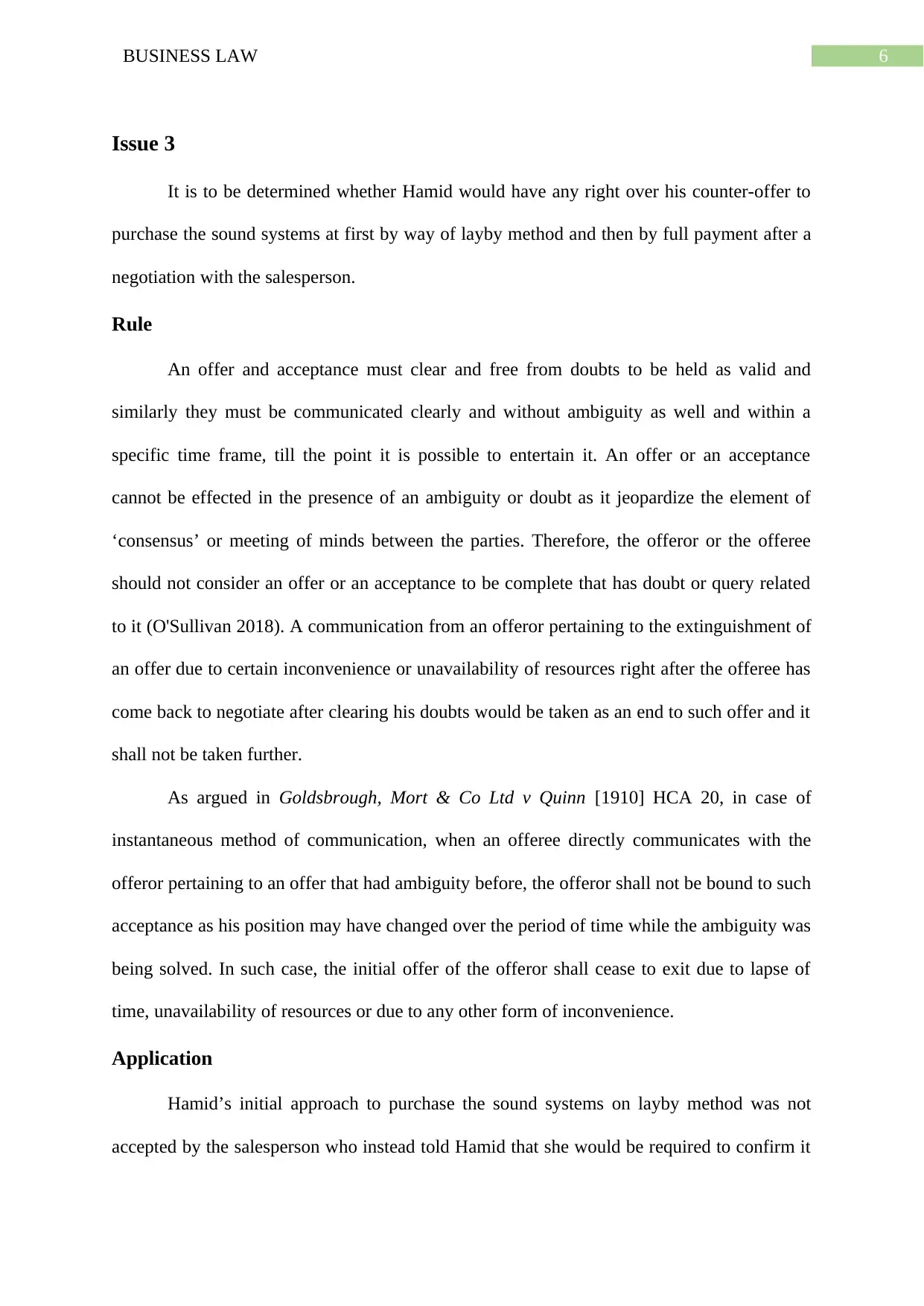
6BUSINESS LAW
Issue 3
It is to be determined whether Hamid would have any right over his counter-offer to
purchase the sound systems at first by way of layby method and then by full payment after a
negotiation with the salesperson.
Rule
An offer and acceptance must clear and free from doubts to be held as valid and
similarly they must be communicated clearly and without ambiguity as well and within a
specific time frame, till the point it is possible to entertain it. An offer or an acceptance
cannot be effected in the presence of an ambiguity or doubt as it jeopardize the element of
‘consensus’ or meeting of minds between the parties. Therefore, the offeror or the offeree
should not consider an offer or an acceptance to be complete that has doubt or query related
to it (O'Sullivan 2018). A communication from an offeror pertaining to the extinguishment of
an offer due to certain inconvenience or unavailability of resources right after the offeree has
come back to negotiate after clearing his doubts would be taken as an end to such offer and it
shall not be taken further.
As argued in Goldsbrough, Mort & Co Ltd v Quinn [1910] HCA 20, in case of
instantaneous method of communication, when an offeree directly communicates with the
offeror pertaining to an offer that had ambiguity before, the offeror shall not be bound to such
acceptance as his position may have changed over the period of time while the ambiguity was
being solved. In such case, the initial offer of the offeror shall cease to exit due to lapse of
time, unavailability of resources or due to any other form of inconvenience.
Application
Hamid’s initial approach to purchase the sound systems on layby method was not
accepted by the salesperson who instead told Hamid that she would be required to confirm it
Issue 3
It is to be determined whether Hamid would have any right over his counter-offer to
purchase the sound systems at first by way of layby method and then by full payment after a
negotiation with the salesperson.
Rule
An offer and acceptance must clear and free from doubts to be held as valid and
similarly they must be communicated clearly and without ambiguity as well and within a
specific time frame, till the point it is possible to entertain it. An offer or an acceptance
cannot be effected in the presence of an ambiguity or doubt as it jeopardize the element of
‘consensus’ or meeting of minds between the parties. Therefore, the offeror or the offeree
should not consider an offer or an acceptance to be complete that has doubt or query related
to it (O'Sullivan 2018). A communication from an offeror pertaining to the extinguishment of
an offer due to certain inconvenience or unavailability of resources right after the offeree has
come back to negotiate after clearing his doubts would be taken as an end to such offer and it
shall not be taken further.
As argued in Goldsbrough, Mort & Co Ltd v Quinn [1910] HCA 20, in case of
instantaneous method of communication, when an offeree directly communicates with the
offeror pertaining to an offer that had ambiguity before, the offeror shall not be bound to such
acceptance as his position may have changed over the period of time while the ambiguity was
being solved. In such case, the initial offer of the offeror shall cease to exit due to lapse of
time, unavailability of resources or due to any other form of inconvenience.
Application
Hamid’s initial approach to purchase the sound systems on layby method was not
accepted by the salesperson who instead told Hamid that she would be required to confirm it
Paraphrase This Document
Need a fresh take? Get an instant paraphrase of this document with our AI Paraphraser
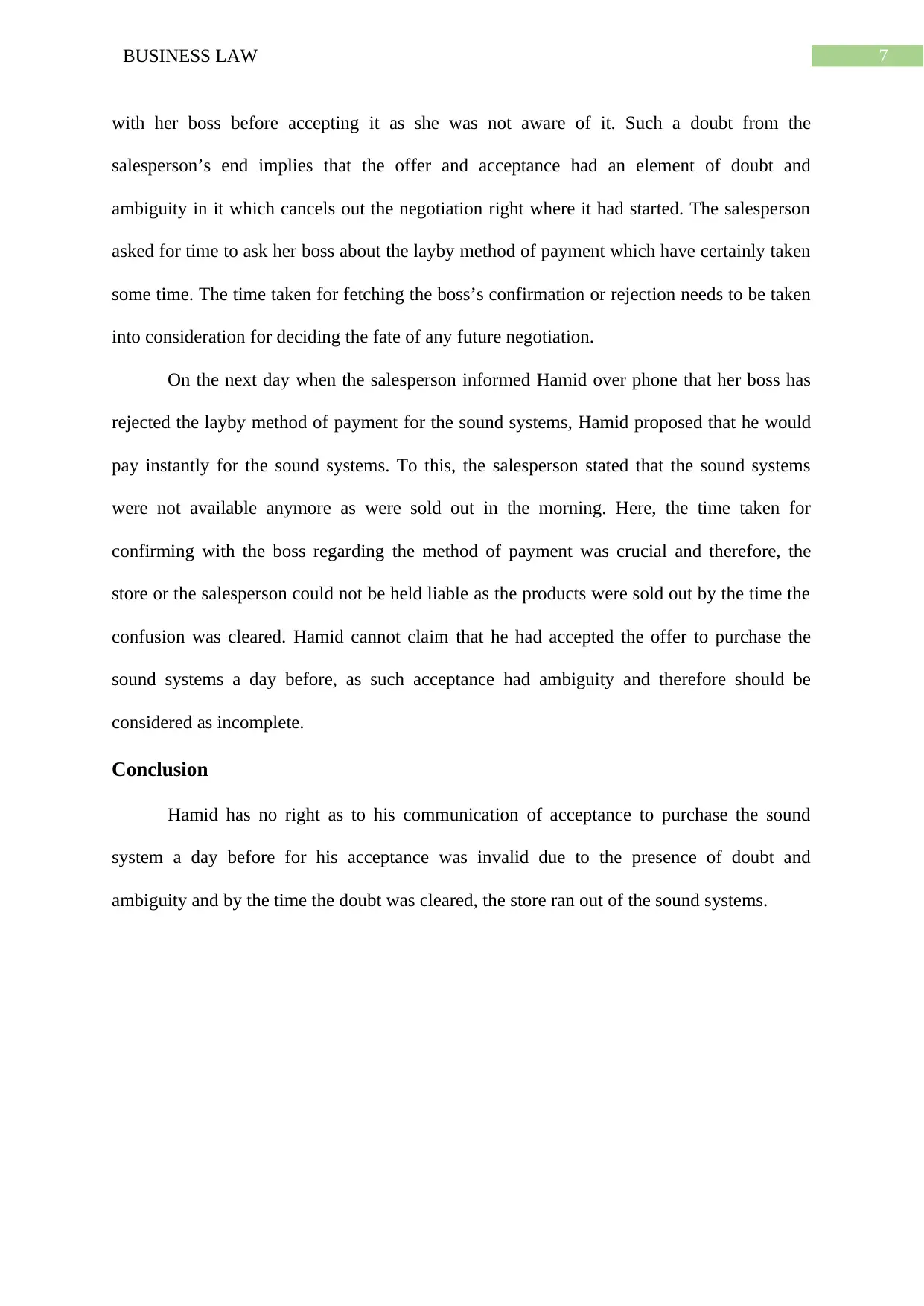
7BUSINESS LAW
with her boss before accepting it as she was not aware of it. Such a doubt from the
salesperson’s end implies that the offer and acceptance had an element of doubt and
ambiguity in it which cancels out the negotiation right where it had started. The salesperson
asked for time to ask her boss about the layby method of payment which have certainly taken
some time. The time taken for fetching the boss’s confirmation or rejection needs to be taken
into consideration for deciding the fate of any future negotiation.
On the next day when the salesperson informed Hamid over phone that her boss has
rejected the layby method of payment for the sound systems, Hamid proposed that he would
pay instantly for the sound systems. To this, the salesperson stated that the sound systems
were not available anymore as were sold out in the morning. Here, the time taken for
confirming with the boss regarding the method of payment was crucial and therefore, the
store or the salesperson could not be held liable as the products were sold out by the time the
confusion was cleared. Hamid cannot claim that he had accepted the offer to purchase the
sound systems a day before, as such acceptance had ambiguity and therefore should be
considered as incomplete.
Conclusion
Hamid has no right as to his communication of acceptance to purchase the sound
system a day before for his acceptance was invalid due to the presence of doubt and
ambiguity and by the time the doubt was cleared, the store ran out of the sound systems.
with her boss before accepting it as she was not aware of it. Such a doubt from the
salesperson’s end implies that the offer and acceptance had an element of doubt and
ambiguity in it which cancels out the negotiation right where it had started. The salesperson
asked for time to ask her boss about the layby method of payment which have certainly taken
some time. The time taken for fetching the boss’s confirmation or rejection needs to be taken
into consideration for deciding the fate of any future negotiation.
On the next day when the salesperson informed Hamid over phone that her boss has
rejected the layby method of payment for the sound systems, Hamid proposed that he would
pay instantly for the sound systems. To this, the salesperson stated that the sound systems
were not available anymore as were sold out in the morning. Here, the time taken for
confirming with the boss regarding the method of payment was crucial and therefore, the
store or the salesperson could not be held liable as the products were sold out by the time the
confusion was cleared. Hamid cannot claim that he had accepted the offer to purchase the
sound systems a day before, as such acceptance had ambiguity and therefore should be
considered as incomplete.
Conclusion
Hamid has no right as to his communication of acceptance to purchase the sound
system a day before for his acceptance was invalid due to the presence of doubt and
ambiguity and by the time the doubt was cleared, the store ran out of the sound systems.
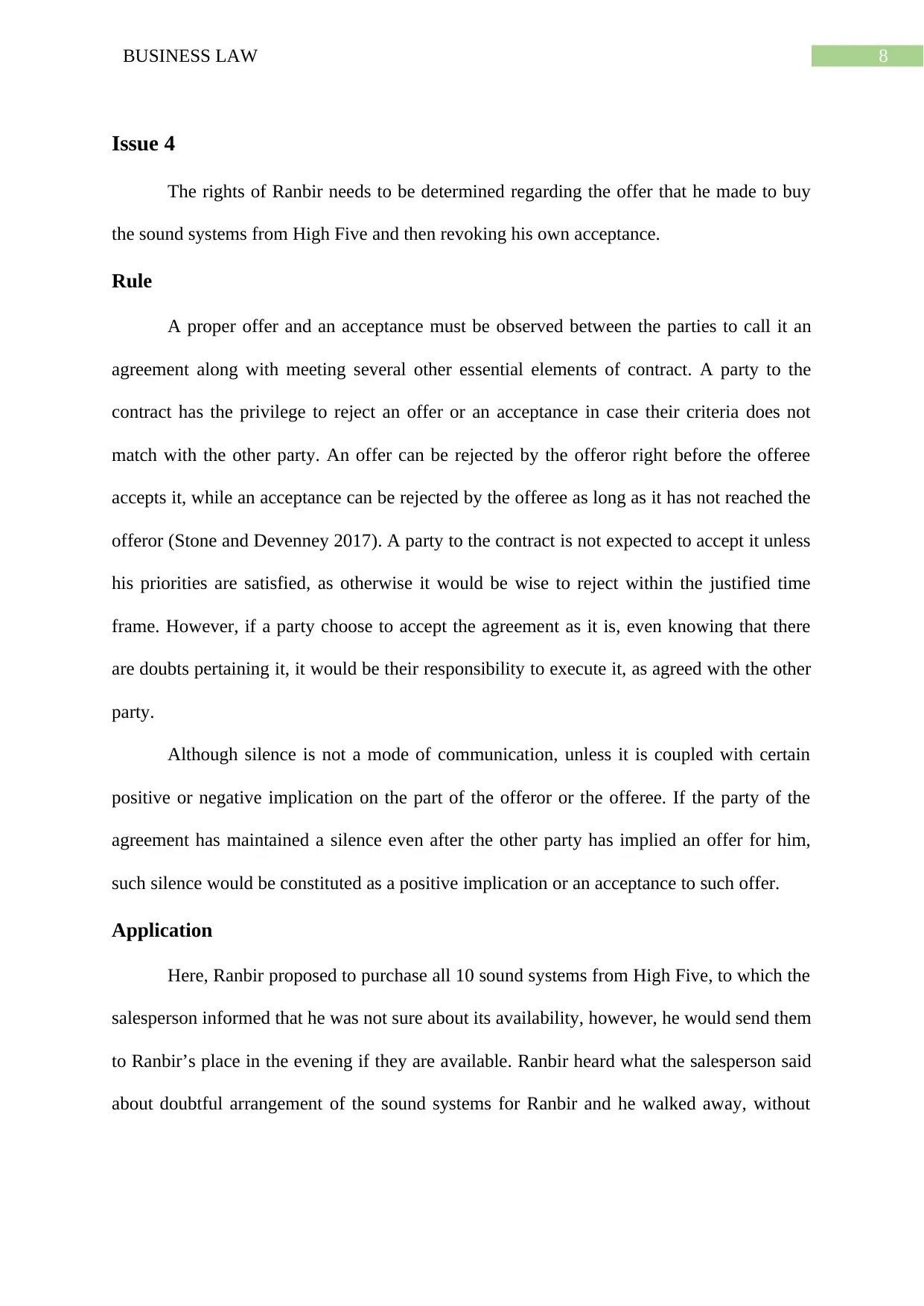
8BUSINESS LAW
Issue 4
The rights of Ranbir needs to be determined regarding the offer that he made to buy
the sound systems from High Five and then revoking his own acceptance.
Rule
A proper offer and an acceptance must be observed between the parties to call it an
agreement along with meeting several other essential elements of contract. A party to the
contract has the privilege to reject an offer or an acceptance in case their criteria does not
match with the other party. An offer can be rejected by the offeror right before the offeree
accepts it, while an acceptance can be rejected by the offeree as long as it has not reached the
offeror (Stone and Devenney 2017). A party to the contract is not expected to accept it unless
his priorities are satisfied, as otherwise it would be wise to reject within the justified time
frame. However, if a party choose to accept the agreement as it is, even knowing that there
are doubts pertaining it, it would be their responsibility to execute it, as agreed with the other
party.
Although silence is not a mode of communication, unless it is coupled with certain
positive or negative implication on the part of the offeror or the offeree. If the party of the
agreement has maintained a silence even after the other party has implied an offer for him,
such silence would be constituted as a positive implication or an acceptance to such offer.
Application
Here, Ranbir proposed to purchase all 10 sound systems from High Five, to which the
salesperson informed that he was not sure about its availability, however, he would send them
to Ranbir’s place in the evening if they are available. Ranbir heard what the salesperson said
about doubtful arrangement of the sound systems for Ranbir and he walked away, without
Issue 4
The rights of Ranbir needs to be determined regarding the offer that he made to buy
the sound systems from High Five and then revoking his own acceptance.
Rule
A proper offer and an acceptance must be observed between the parties to call it an
agreement along with meeting several other essential elements of contract. A party to the
contract has the privilege to reject an offer or an acceptance in case their criteria does not
match with the other party. An offer can be rejected by the offeror right before the offeree
accepts it, while an acceptance can be rejected by the offeree as long as it has not reached the
offeror (Stone and Devenney 2017). A party to the contract is not expected to accept it unless
his priorities are satisfied, as otherwise it would be wise to reject within the justified time
frame. However, if a party choose to accept the agreement as it is, even knowing that there
are doubts pertaining it, it would be their responsibility to execute it, as agreed with the other
party.
Although silence is not a mode of communication, unless it is coupled with certain
positive or negative implication on the part of the offeror or the offeree. If the party of the
agreement has maintained a silence even after the other party has implied an offer for him,
such silence would be constituted as a positive implication or an acceptance to such offer.
Application
Here, Ranbir proposed to purchase all 10 sound systems from High Five, to which the
salesperson informed that he was not sure about its availability, however, he would send them
to Ranbir’s place in the evening if they are available. Ranbir heard what the salesperson said
about doubtful arrangement of the sound systems for Ranbir and he walked away, without
⊘ This is a preview!⊘
Do you want full access?
Subscribe today to unlock all pages.

Trusted by 1+ million students worldwide
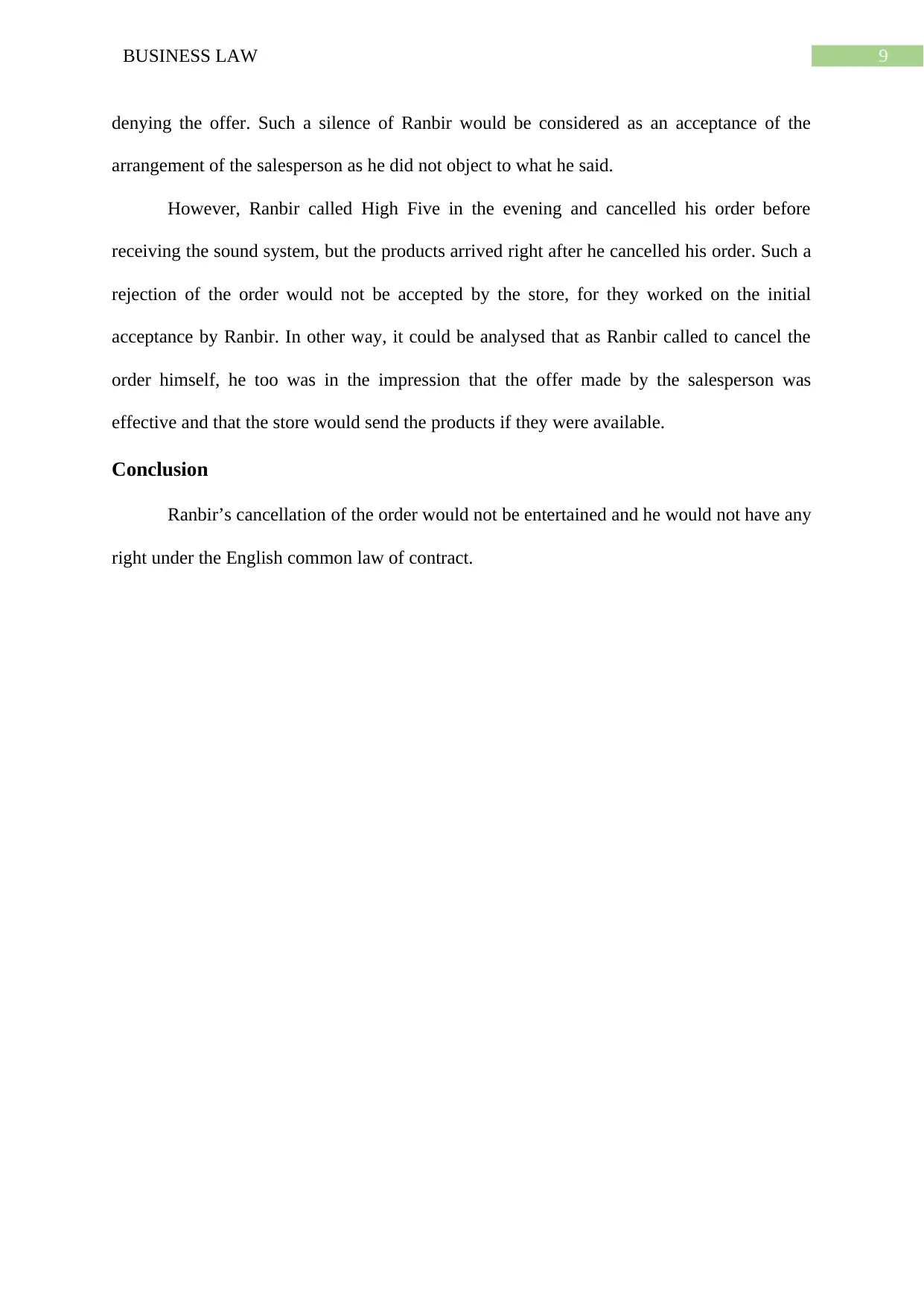
9BUSINESS LAW
denying the offer. Such a silence of Ranbir would be considered as an acceptance of the
arrangement of the salesperson as he did not object to what he said.
However, Ranbir called High Five in the evening and cancelled his order before
receiving the sound system, but the products arrived right after he cancelled his order. Such a
rejection of the order would not be accepted by the store, for they worked on the initial
acceptance by Ranbir. In other way, it could be analysed that as Ranbir called to cancel the
order himself, he too was in the impression that the offer made by the salesperson was
effective and that the store would send the products if they were available.
Conclusion
Ranbir’s cancellation of the order would not be entertained and he would not have any
right under the English common law of contract.
denying the offer. Such a silence of Ranbir would be considered as an acceptance of the
arrangement of the salesperson as he did not object to what he said.
However, Ranbir called High Five in the evening and cancelled his order before
receiving the sound system, but the products arrived right after he cancelled his order. Such a
rejection of the order would not be accepted by the store, for they worked on the initial
acceptance by Ranbir. In other way, it could be analysed that as Ranbir called to cancel the
order himself, he too was in the impression that the offer made by the salesperson was
effective and that the store would send the products if they were available.
Conclusion
Ranbir’s cancellation of the order would not be entertained and he would not have any
right under the English common law of contract.
Paraphrase This Document
Need a fresh take? Get an instant paraphrase of this document with our AI Paraphraser
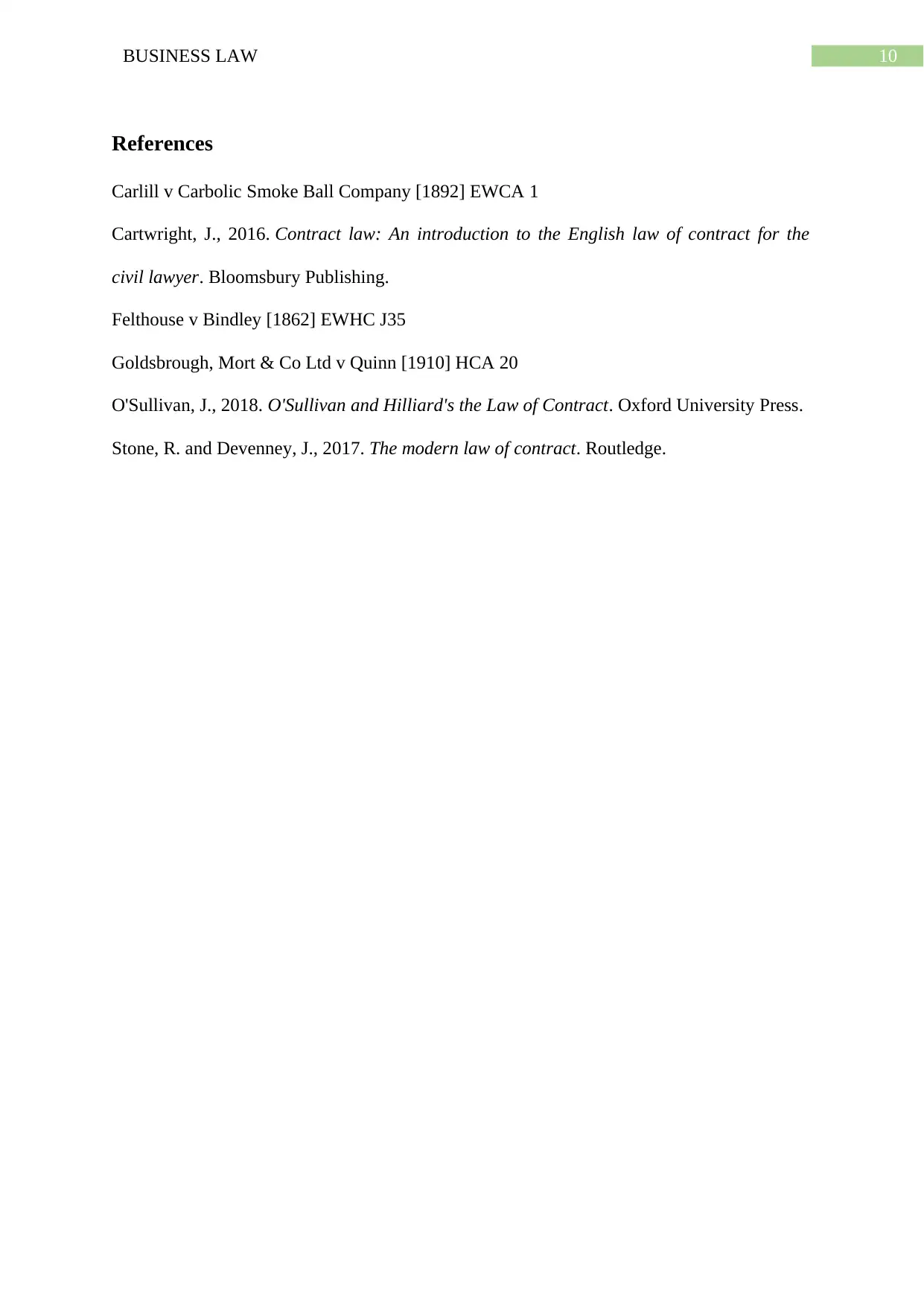
10BUSINESS LAW
References
Carlill v Carbolic Smoke Ball Company [1892] EWCA 1
Cartwright, J., 2016. Contract law: An introduction to the English law of contract for the
civil lawyer. Bloomsbury Publishing.
Felthouse v Bindley [1862] EWHC J35
Goldsbrough, Mort & Co Ltd v Quinn [1910] HCA 20
O'Sullivan, J., 2018. O'Sullivan and Hilliard's the Law of Contract. Oxford University Press.
Stone, R. and Devenney, J., 2017. The modern law of contract. Routledge.
References
Carlill v Carbolic Smoke Ball Company [1892] EWCA 1
Cartwright, J., 2016. Contract law: An introduction to the English law of contract for the
civil lawyer. Bloomsbury Publishing.
Felthouse v Bindley [1862] EWHC J35
Goldsbrough, Mort & Co Ltd v Quinn [1910] HCA 20
O'Sullivan, J., 2018. O'Sullivan and Hilliard's the Law of Contract. Oxford University Press.
Stone, R. and Devenney, J., 2017. The modern law of contract. Routledge.
1 out of 11
Related Documents
Your All-in-One AI-Powered Toolkit for Academic Success.
+13062052269
info@desklib.com
Available 24*7 on WhatsApp / Email
![[object Object]](/_next/static/media/star-bottom.7253800d.svg)
Unlock your academic potential
Copyright © 2020–2026 A2Z Services. All Rights Reserved. Developed and managed by ZUCOL.





